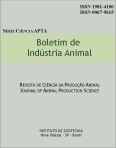Efficiency of feed utilization in young Nellore animals of different genders
Keywords:
feed conversion, feed efficiency, residual feed intakeAbstract
In study of more efficient animals for food utilization, it is of great importance to know differences between genders. There are differences between male and female cattle in growing and body composition, mainly those related to the action of sex hormones. This study aimed to evaluate the sex effect on feed efficiency traits in young Nellore animals. Individual feed intake data from eight tests, performed from 2005 to 2012 at Centro APTA Bovinos de Corte-Instituto de Zootecnia-Sertãozinho-SP were utilized. The tests began after weaning, when the animals had, on average, 286 days of age and 229 kg of body weight. The tests duration ranged from 56 to 112 days, depending on the year. Traits analyzed were final body weight (FBW), dry matter intake (DMI), average daily gain (ADG), feed conversion ratio (FCR), feed efficiency ratio (FER), residual feed intake (RFI) and Kleiber ratio (KR). Data were analyzed using the MIXED procedure of SAS. The model included the fixed effect age at the test beginning as linear covariate and the random effects: sex, facilities and year. Least square means were calculated and compared by t test. Males had greater FBW than females, what was expected, due to the action of male hormones which benefits the muscle deposition. Greater means of ADG and DMI were also detected for males, when compared to females, because heavier animals have higher gains and consume food according to their body sizes. Among all the feed efficiency measures studied, significant differences between males and females were detected in FCR and KR. Analyzing FCR, females used more food than males for 1 kg of body weight gain, being less efficient. The same was found when KR was analyzed, having males higher KR and being more efficient. No significant differences were detected between males and females for FER and RFI. Young Nellore females are less efficient than males in this growth stage, because of the differences in growth curves due to the sex hormones action.Downloads
Downloads
Published
Issue
Section
License
Os autores não serão remunerados pela publicação de trabalhos, pois devem abrir mão de seus direitos autorais em favor deste periódico. Por outro lado, os autores ficam autorizados a publicar seus artigos, simultaneamente, em repositórios da instituição de sua origem, desde que citada a fonte da publicação original seja Boletim de Indústria Animal. A revista se reserva o direito de efetuar, nos originais, alterações de ordem normativa, ortográfica e gramatical, com vistas a manter o padrão culto da língua e a credibilidade do veículo. Respeitará, no entanto, o estilo de escrever dos autores. Alterações, correções ou sugestões de ordem conceitual serão encaminhadas aos autores, quando necessário. Nesses casos, os artigos, depois de adequados, deverão ser submetidos a nova apreciação. As opiniões emitidas pelos autores dos artigos são de sua exclusiva responsabilidade. Todo o conteúdo deste periódico, exceto onde está identificado, está licenciado sob a Licença Creative Commons Attribution (CC-BY-NC). A condição BY implica que os licenciados podem copiar, distribuir, exibir e executar a obra e fazer trabalhos derivados com base em que só se dão o autor ou licenciante os créditos na forma especificada por estes. A cláusula NC significa que os licenciados podem copiar, distribuir, exibir e executar a obra e fazer trabalhos derivados com base apenas para fins não comerciais.













